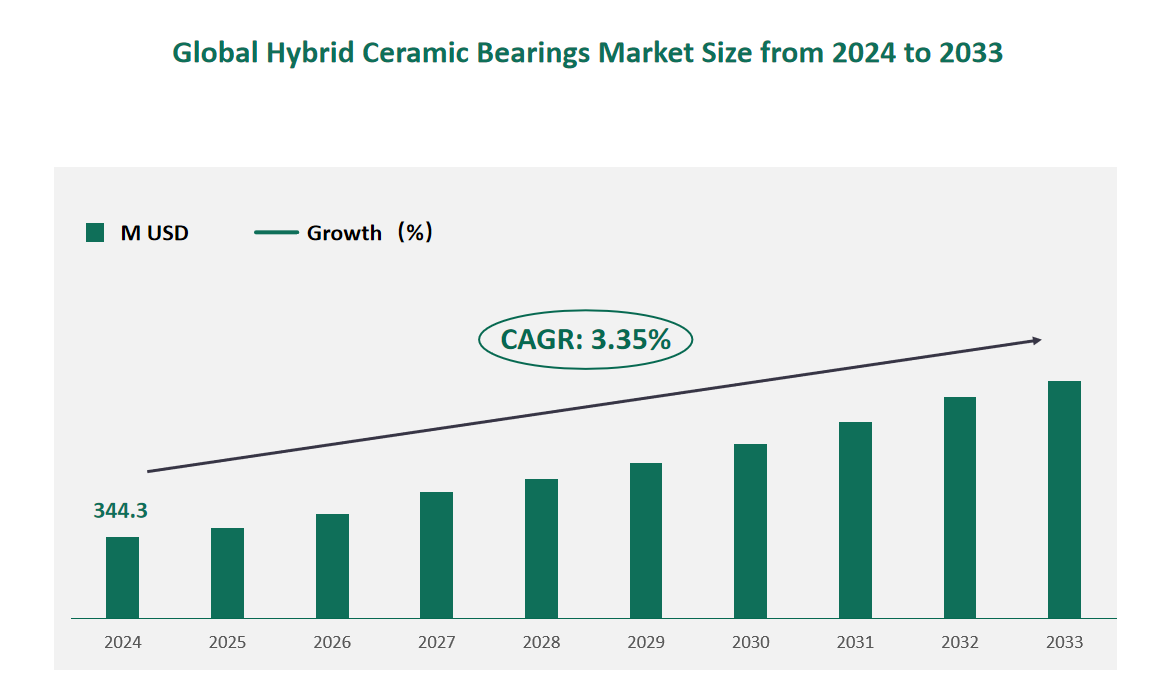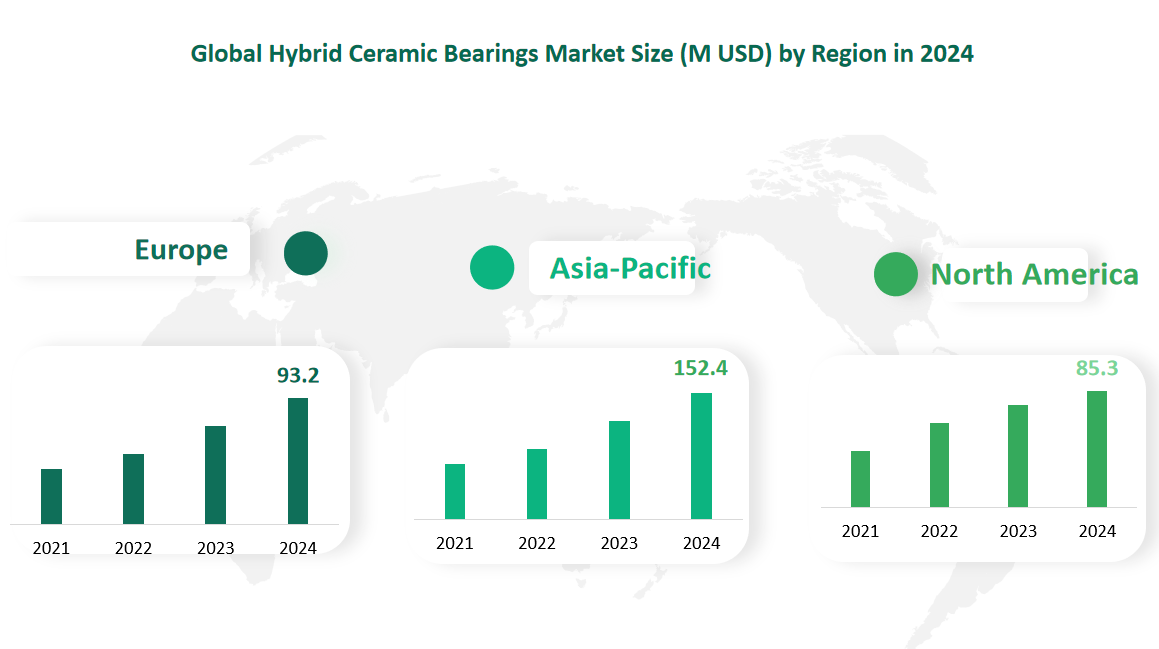1 Global Hybrid Ceramic Bearings Market Size (Value) and CAGR (2024-2033)
In 2024, the global Hybrid Ceramic Bearings market was valued at USD 344.3 million, with a CAGR of 3.35% from 2024 to 2033.
Hybrid ceramic ball bearings usually refer to the bearing assembly consisting of steel inner and outer rings, with ceramic balls made of silicon nitride (Si3N4), zirconium dioxide (ZrO2), and silicon carbide. Hybrid ceramic bearings combine the excellent properties of metal and ceramics. Hybrid ceramic bearings are particularly suitable for high-speed, high-precision and long-life steel ceramic hybrid bearings rolling elements (the inner and outer rings are made of metal). As the basic part of the carrier machinery rotation, it has been widely used in various special environments and harsh environments due to its excellent performance unmatched by metal bearings.
Figure Global Hybrid Ceramic Bearings Market Size (M USD) and CAGR 2024-2033

2 Hybrid Ceramic Bearings Market Drivers
Hybrid ceramic bearings combine the best properties of metal and ceramic materials, offering unmatched performance in high-speed, high-precision, and long-life applications. The use of ceramic materials such as silicon nitride (Si3N4) provides several advantages over traditional steel bearings. These include lower density, higher hardness, reduced friction, excellent wear resistance, and superior insulation properties. These characteristics make hybrid ceramic bearings ideal for use in harsh environments, such as aerospace, automotive, industrial machinery, and energy sectors, where traditional bearings may fail due to high temperatures, corrosion, or electrical conductivity issues.
Advancements in manufacturing technology have significantly reduced the production costs of hybrid ceramic bearings. As a result, these bearings are becoming more accessible and affordable for a wider range of applications. The continuous improvement in processing techniques and the increasing level of craftsmanship have enabled manufacturers to produce high-quality hybrid ceramic bearings at a lower cost. This has led to a broader adoption of these bearings in various industries, driving market growth. Additionally, the development of new materials and production methods is expected to further enhance the performance and cost-effectiveness of hybrid ceramic bearings in the future.
The increasing demand for hybrid ceramic bearings is a significant driver of market growth. These bearings are widely used in industries such as aerospace, automotive, industrial machinery, and energy, where their superior performance is essential. In the aerospace industry, hybrid ceramic bearings are used in aircraft engines and other critical components due to their ability to withstand high temperatures and provide excellent insulation. In the automotive sector, these bearings are used in turbochargers and electric motors to improve efficiency and reduce friction. The growing demand for high-performance bearings in these industries is expected to drive the market forward.
3 Hybrid Ceramic Bearings Market Restraints
One of the primary challenges in the Hybrid Ceramic Bearings market is the high cost associated with research and development (R&D). The manufacturing process of hybrid ceramic bearings is complex and requires advanced technology and expertise. This complexity results in significant R&D costs for manufacturers, which can be a barrier to entry for new players. Additionally, the need for continuous innovation to improve performance and reduce costs further increases the financial burden on companies. This high R&D expenditure can limit the market’s growth by restricting the number of participants and slowing down the pace of technological advancements.
The production of hybrid ceramic bearings involves intricate processes and high-quality raw materials, leading to higher production costs compared to traditional steel bearings. The complexity of the manufacturing process and the need for precision in production result in higher labor and material costs. This, in turn, makes hybrid ceramic bearings more expensive than their steel counterparts. The higher price point can limit their adoption in cost-sensitive applications and industries, where traditional bearings may still be preferred due to lower costs. Additionally, the limited supply of high-quality raw materials and specialized manufacturing equipment can further restrict the production capacity and market availability of hybrid ceramic bearings.
4 Global Hybrid Ceramic Bearings Market Size by Type in 2024
In 2024, the market size for hybrid ceramic bearings made from Si3N4 (Silicon Nitride) material is expected to reach 317.6 million USD. Si3N4 is the most widely used material in hybrid ceramic bearings due to its exceptional properties. These bearings combine steel inner and outer rings with ceramic balls made of silicon nitride, offering several advantages over traditional steel bearings. Si3N4 bearings are known for their low density, high hardness, low friction coefficient, excellent wear resistance, and superior insulation properties.
These characteristics make them ideal for high-speed, high-precision, and long-life applications, particularly in industries such as aerospace, automotive, and industrial machinery. The high performance and reliability of Si3N4 bearings have led to their widespread adoption, contributing significantly to the overall market size.
The market size for hybrid ceramic bearings made from non-Si3N4 materials, such as zirconium dioxide (ZrO2) and silicon carbide (SiC), is projected to be 26.7 million USD in 2024. Non-Si3N4 bearings offer unique advantages depending on the specific material used. For example, zirconium dioxide is known for its excellent thermal stability and resistance to corrosion, making it suitable for applications in harsh environments. Silicon carbide, on the other hand, provides high hardness and wear resistance, making it ideal for applications where extreme durability is required.
Table Global Hybrid Ceramic Bearings Market Size by Type in 2024
Type | 2024 |
Si3N4 Material | 317.6 |
Non-Si3N4 Material | 26.7 |
5 Global Hybrid Ceramic Bearings Market Size by Application in 2024
The Transportation sector is one of the largest consumers of hybrid ceramic bearings, with a market size projected to reach 57.9 million USD in 2024. Hybrid ceramic bearings are used extensively in automotive applications, such as turbochargers, where their high-speed capabilities and low friction reduce energy consumption and improve efficiency. Additionally, these bearings are used in electric vehicles to enhance performance and durability, making them essential for the growing transportation industry.
The Machinery sector is another significant application area for hybrid ceramic bearings, with a market size expected to reach 83.9 million USD in 2024. These bearings are used in various industrial machinery applications, including high-speed spindles, machine tools, and robotic systems. Their high precision and durability make them ideal for applications requiring long service life and minimal maintenance.
The Energy sector, particularly renewable energy applications, is a growing market for hybrid ceramic bearings, with a projected market size of 40.0 million USD in 2024. These bearings are used in wind turbines, electric motors, and other energy generation equipment due to their ability to withstand harsh environmental conditions and provide high reliability. Their low friction and wear resistance contribute to improved efficiency and reduced maintenance costs in energy applications.
The Industrial sector is a broad application area that includes manufacturing, automation, and general industrial equipment. The market size for hybrid ceramic bearings in this sector is projected to reach 97.5 million USD in 2024. These bearings are used in a variety of applications, including conveyor systems, pumps, and compressors, where their high performance and durability are crucial for maintaining operational efficiency and reducing downtime.
Table Global Hybrid Ceramic Bearings Market Size by Application in 2024
Application | Market Size (M USD) 2024 |
Transportation | 57.9 |
Machinery | 83.9 |
Energy | 40.0 |
Industrial | 97.5 |
Aerospace | 48.8 |
Others | 16.1 |
6 Global Hybrid Ceramic Bearings Market Size by Region in 2024
North America is a significant market for hybrid ceramic bearings, with a projected market size of 85.3 million USD in 2024. The region’s strong industrial base, particularly in the automotive and aerospace sectors, drives demand for high-performance bearings. The United States and Canada are the primary markets, with the U.S. accounting for the majority of the region’s demand. The presence of major manufacturers and technological advancements in these industries further supports market growth.
Europe is another key market, with a projected size of 93.2 million USD in 2024. The region’s robust manufacturing sector, especially in Germany, France, and the UK, drives demand for hybrid ceramic bearings. The automotive and aerospace industries are major consumers, with a focus on high precision and reliability. Europe’s emphasis on technological innovation and sustainability also supports the adoption of hybrid ceramic bearings in various applications.
The Asia-Pacific region is the largest market for hybrid ceramic bearings, with a projected size of 152.4 million USD in 2024. China, Japan, and South Korea are the primary markets, driven by rapid industrialization, technological advancements, and growing demand from the automotive, aerospace, and energy sectors. The region’s strong manufacturing base and increasing investment in research and development contribute to its dominant market position. Additionally, the growing adoption of hybrid ceramic bearings in emerging economies such as India and Southeast Asia further supports market growth.
Figure Global Hybrid Ceramic Bearings Market Size by Region in 2024

7 Major Players in Global Hybrid Ceramic Bearings Market
7.1 Schaeffler
Company Profile: Schaeffler is a leading automotive and industrial supplier headquartered in Germany. Established in 1883, the company has a global presence with manufacturing bases in China, Europe, and North America. Schaeffler is renowned for its innovative solutions in engine, transmission, and chassis systems, as well as industrial applications.
Business Overview: Schaeffler’s business divisions include automotive original equipment, automotive aftermarket, industrial original equipment, and industrial aftermarket. The company focuses on developing high-performance bearings and components that enhance efficiency and reliability across various industries.
Product Offered: Schaeffler offers a wide range of hybrid ceramic bearings, including FAG Cronitect Hybrid Bearings, which combine steel rings with ceramic rolling elements. These bearings are designed for high-speed, high-precision applications and provide superior smooth running and reliability.
Recent Financial Data: In 2020, Schaeffler’s hybrid ceramic bearings generated a revenue of 44.8 million USD.
7.2 SKF
Company Profile: SKF is a global leader in bearings, seals, mechatronics, and lubrication systems. Established in 1907 and headquartered in Sweden, SKF has a strong presence in China, Europe, and the USA. The company is known for its extensive product portfolio and commitment to sustainability and innovation.
Business Overview: SKF’s business segments include industrial and automotive applications. The company provides a wide range of products and services, including rolling bearings, plain bearings, seals, and mechatronic products. SKF’s focus on sustainability and digitalization has positioned it as a leader in the industry.
Product Offered: SKF offers hybrid ceramic ball bearings that combine traditional steel rings with silicon nitride (ceramic) balls. These bearings are designed to provide higher speed capabilities, longer service life, and excellent insulation properties, making them ideal for applications in the automotive, aerospace, and industrial sectors.
Recent Financial Data: In 2020, SKF’s hybrid ceramic bearings generated a revenue of 39 million USD.
7.3 Minebea
Company Profile: Minebea is a leading manufacturer of miniature and instrument ball bearings, headquartered in Japan. Established in 1951, the company has a global presence with manufacturing bases in Asia, Europe, and North America. Minebea is known for its high-quality products and innovative technologies.
Business Overview: Minebea’s business segments include miniature and instrument ball bearings, DC motors, and other precision components. The company focuses on providing high-precision solutions for various industries, including automotive, aerospace, and industrial machinery. Minebea’s commitment to quality and innovation has positioned it as a key player in the hybrid ceramic bearings market.
Product Offered: Minebea offers a range of hybrid ceramic bearings, including CEROBEAR hybrid roller bearings. These bearings are designed for high-performance applications where weight, speed, and durability are critical. Minebea’s advanced ceramic material technology ensures superior performance and reliability in harsh operating conditions.
Recent Financial Data: In 2020, Minebea’s hybrid ceramic bearings generated a revenue of 38.7 million USD.

